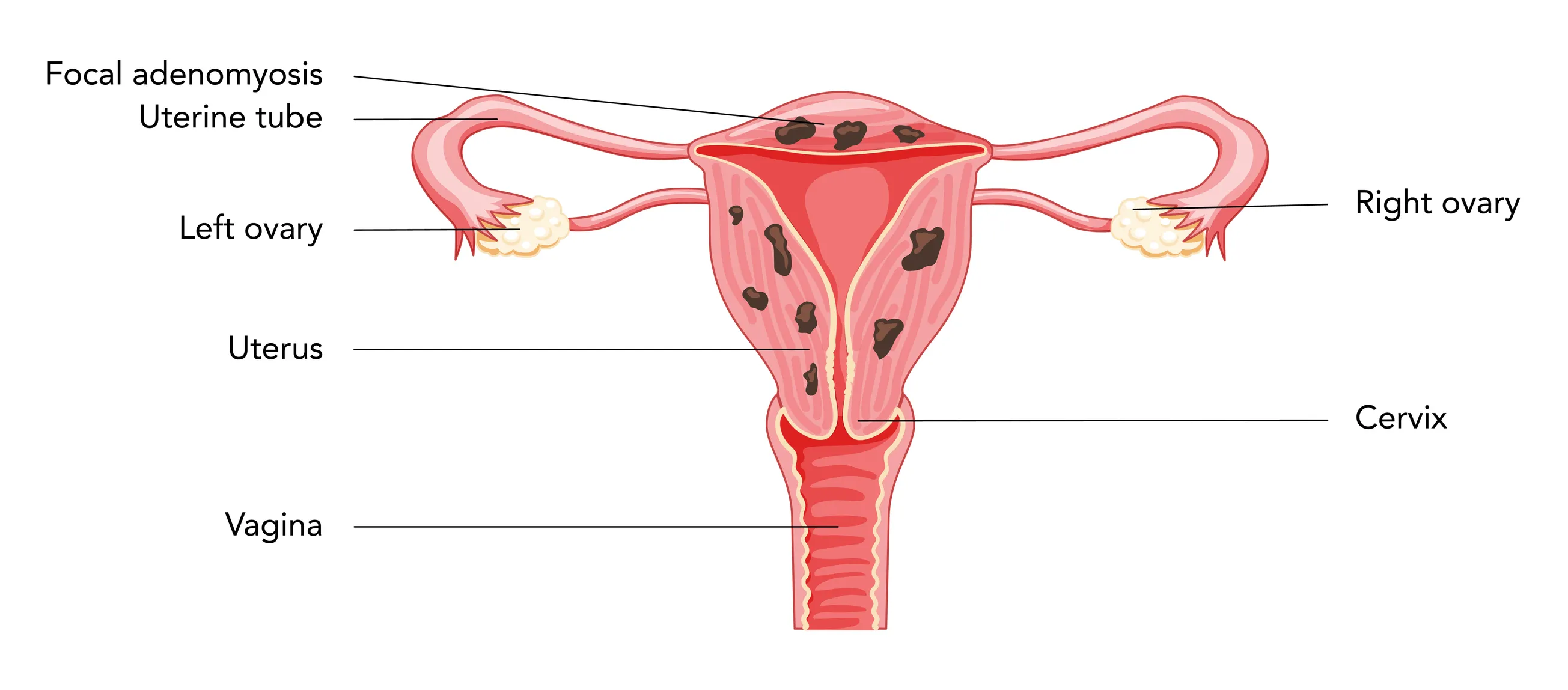.webp?sfvrsn=51feb3db_1)
Endometriosi
Endometriosis is a medical condition whereby the endometrial tissue that normally lines the inside of the uterus grows outside the uterus. This misplaced tissue can develop on various pelvic organs such as the ovaries, fallopian tubes, and other structures within the pelvic cavity.

Endometriosis affects approximately 10% of women, making it a relatively common condition. Having a family history of endometriosis, particularly if your mother or sister has been diagnosed, increases the likelihood of developing the condition.
Endometriosis primarily affects women in their reproductive years. It is often a chronic condition that can impact your overall physical health, emotional well-being, and daily life.
Adenomyosis
Adenomyosis is a condition where the tissue that usually lines the inner walls of the uterus grows into the muscle layer of the uterus. It can affect either the entire uterus or a specific area of it.

While adenomyosis is not life-threatening, its symptoms can significantly impact your daily life. Therefore, seeking appropriate medical care is crucial to address and manage the condition effectively.
Differences between endometriosis and adenomyosis
Endometriosis and adenomyosis are separate medical conditions that both impact the uterus and may present similar symptoms. It is possible for a woman to have both conditions simultaneously. While the two conditions share some similarities, they have distinct differences too.
In endometriosis, the endometrial tissue that normally lines the inside of the uterus grows outside of the uterus.
In adenomyosis, the endometrial tissue that normally lines the inside of the uterus grows into the muscular wall of the uterus.
Risk factors for endometriosis and adenomyosis
Endometriosis and adenomyosis are both conditions that affect the uterus and can cause significant pain and discomfort. The exact causes of these conditions are not fully understood.
Below are potential risk factors that may contribute to the development of endometriosis and adenomyosis.
Risk factors for endometriosis
Risk factors for adenomyosis
Symptoms of endometriosis and adenomyosis
The symptoms of endometriosis and adenomyosis can vary from person to person, and some women may not experience any symptoms at all.
Symptoms of endometriosis
.webp?sfvrsn=6fded1cf_1)
Symptoms of adenomyosis
Diagnosis of endometriosis and adenomyosis
Your doctor would first question your general health and symptoms before conducting a thorough physical examination. Diagnosis is made based on your reported symptoms, physical examination, and investigations.
Treatment options for endometriosis and adenomyosis
The treatment options for endometriosis and adenomyosis depend on the severity of the symptoms and the individual's goals, such as improving fertility or relieving pain. Treatment options may include:
Pain medication
Nonsteroidal anti-inflammatory drugs (NSAIDs) such as ibuprofen and naproxen can help relieve menstrual pain due to endometriosis and adenomyosis.
Hormonal therapy
Hormonal imbalances that cause endometriosis and adenomyosis symptoms can be regulated by hormonal treatments such as birth control pills, progestins or Gonadotropin-Releasing Hormone (GnRH) agonists.
Laparoscopy
Excision or removal of endometriotic lesions through laparoscopy can provide long-term relief from symptoms and improve fertility in some cases. This approach is often considered for endometriosis.
Hysterectomy
Hysterectomy (surgical procedure to remove the uterus) may be recommended in severe cases of endometriosis or adenomyosis when other treatments have not been effective, or fertility is no longer a concern.
Fertility treatments
To improve the chances of pregnancy, fertility treatments such as medication to induce ovulation, intrauterine insemination (IUI) or in vitro fertilisation (IVF) can be done.
Chances of getting pregnant
While it is possible to get pregnant with endometriosis or adenomyosis, these conditions can make it more challenging to achieve pregnancy. Both conditions have the potential to impact fertility due to factors such as scarring, inflammation, and hormonal imbalances. These factors can interfere with ovulation and the successful implantation of a fertilised egg in the uterus.
However, not all individuals with endometriosis or adenomyosis will experience fertility issues. There are various treatment options available to improve the chances of conception. Consulting with a healthcare professional who specialises in reproductive health can provide further guidance and support.
Make an appointment at Gleneagles Hospitals
Recognising the signs and symptoms of endometriosis and adenomyosis early on allows for timely intervention and the implementation of suitable treatment options.
If you suspect that you are experiencing symptoms of endometriosis or adenomyosis, get in touch with us to find out more about our Obstetrics & Gynaecology Services at your nearest Gleneagles Hospital.

Wait a minute